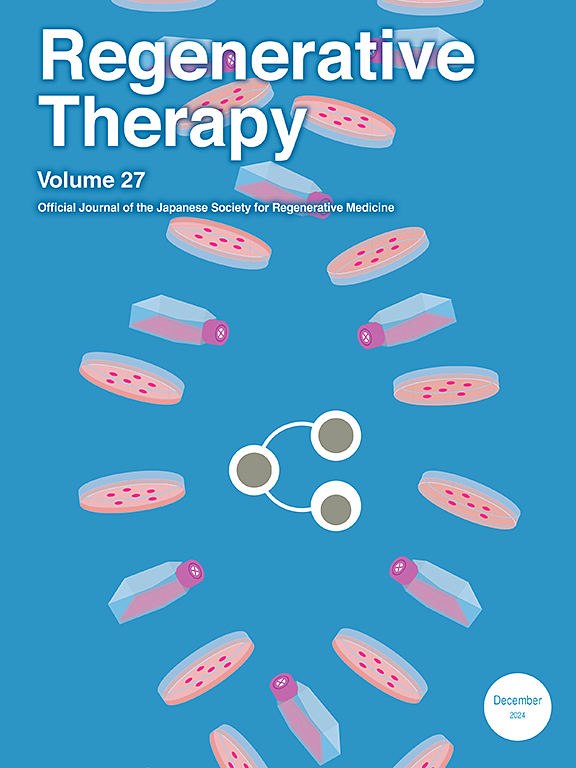Evaluation of the usage of more than 50 sheets of autologous cultured epidermis (JACE®) sheets in treating patients with severe burns beyond insurance coverage limits
IF 3.5
3区 环境科学与生态学
Q3 CELL & TISSUE ENGINEERING
引用次数: 0
Abstract
Background
Autologous cultured epidermis, JACE®, Japan's first regenerative medical product, is used as the standard treatment for wound closure in patients with severe burns. Although this product is listed for national health insurance in Japan, medical institutions place orders for JACE® beyond the limit of 50 sheets calculated for insurance coverage (insurance coverage limit) for lifesaving purposes. Therefore, the manufacturer and distributor continue to provide an excess amount, free from humanitarian considerations.
Methods
As a project supported by the Ministry of Economy, Trade, and Industry, the authors planned and conducted a non-interventional survey on the usage of JACE® from June 21, 2023, to February 29, 2024. In cases where more than 50 sheets of JACE® were used for patients with severe burns, information obtainable at the manufacturing stage and post-treatment feedback from physicians in charge were collected, and the requirement for JACE® were reviewed.
Results
During the survey period, interviews were conducted with physicians in charge at 30 institutions that placed orders for JACE® for the treatment of patients with severe burns. Of 43 patients, 13 received51 or more JACE® sheets. All were used at the request of the physician in charge and were confirmed to contribute to epithelialization, which closes burn wounds and saves lives. The mean age of the 13 patients who received 51 or more JACE® sheets (group H) was 53.2 years, which was lower than the63.1 years in the 30 patients who received 50 or fewer sheets (group L). The mean injured area was 55.9 % in group H and was clearly larger than the 37.0 % in group L. All patients with an injured area of 70 % or more were in group H, and three patients who received 100 or more JACE® sheets, with the highest reaching 165 sheets. In group H, JACE® tended to be used in younger patients with a large injured area and in elderly patients with a small injured area. A total of 434 sheets were provided to medical institutions free of charge to the 13 patients in group H.
Conclusions
Among the number of JACE® orders placed for the treatment of patients with severe burns, 30 % received more sheets than the insurance coverage limit; of the total number of sheets, 20.7 % were provided free of charge to medical institutions. Given this situation, the 50-sheet limit for insurance reimbursements need to be revisited.
评估超过50片自体培养表皮(JACE®)片在治疗超过保险覆盖范围的严重烧伤患者中的使用情况
自体培养表皮是日本第一个再生医疗产品,被用作严重烧伤患者伤口愈合的标准治疗方法。虽然本产品在日本被列入国民健康保险,但医疗机构订购的JACE®超过了以救生为目的的保险范围(保险范围限制)计算的50张限制。因此,制造商和分销商在不考虑人道主义因素的情况下继续提供多余的数量。方法作为日本经济产业省支持的项目,作者计划于2023年6月21日至2024年2月29日对JACE®的使用情况进行非干预性调查。在严重烧伤患者使用超过50张JACE®的情况下,收集了制造阶段可获得的信息和负责医生的治疗后反馈,并审查了JACE®的需求。结果在调查期间,对30家订购JACE®治疗严重烧伤患者的机构的负责人进行了访谈。在43名患者中,13名患者接受了51张或更多的JACE®片。所有这些都是在主治医生的要求下使用的,并被证实有助于上皮化,从而闭合烧伤伤口并挽救生命。接受51张及以上JACE®片的13例患者(H组)的平均年龄为53.2岁,低于接受50张及以下JACE®片的30例患者(L组)的平均年龄63.1岁。H组的平均损伤面积为55.9%,明显大于l组的37.0%。所有损伤面积大于70%的患者均为H组,有3例患者使用了100张及以上的JACE®片,最高达到165张。在H组中,JACE®倾向于用于损伤面积较大的年轻患者和损伤面积较小的老年患者。h组13例患者共向医疗机构免费提供了434张纸。结论在重度烧伤患者的JACE®治疗订单中,30%的患者收到的纸超过了保险覆盖范围;在所有床单中,20.7%是免费提供给医疗机构的。鉴于这种情况,需要重新审议保险报销的50张限额。
本文章由计算机程序翻译,如有差异,请以英文原文为准。
求助全文
约1分钟内获得全文
求助全文
来源期刊

Regenerative Therapy
Engineering-Biomedical Engineering
CiteScore
6.00
自引率
2.30%
发文量
106
审稿时长
49 days
期刊介绍:
Regenerative Therapy is the official peer-reviewed online journal of the Japanese Society for Regenerative Medicine.
Regenerative Therapy is a multidisciplinary journal that publishes original articles and reviews of basic research, clinical translation, industrial development, and regulatory issues focusing on stem cell biology, tissue engineering, and regenerative medicine.
 求助内容:
求助内容: 应助结果提醒方式:
应助结果提醒方式:


